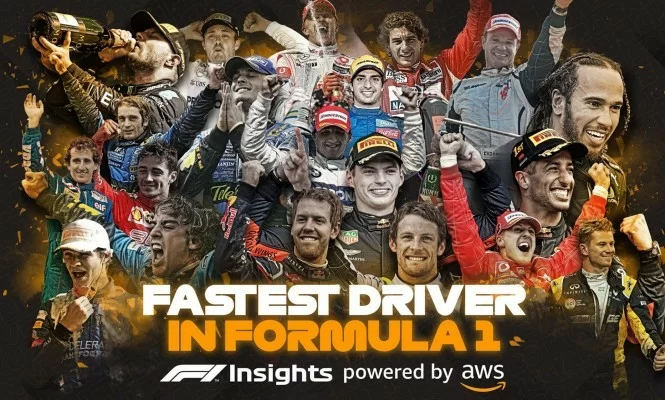It's the debate that has ruled in F1 since ... well, since F1 started, in fact: who is the fastest driver of all? But now, machine learning may have given an answer, with Formula 1 and Amazon Web Services joining forces to dive into the world of the fastest drivers, in a single lap, using data collected since 1983 we can exclusively reveal the 20 Formula drivers 1 at the top - and who is number 1 ...
It took F1 and Amazon Machine Learning Solutions Lab an entire year to build the algorithm that led to the 'Fastest Driver', the latest F1 Insight developed by AWS (Amazon Web Services), which uses machine learning to compare qualification performances of drivers over time in relation to their teammates to establish a final ranking - meaning that a driver of a car with less power is just as likely to appear well as a driver who was fighting for pole position.
The team behind 'Fastest Driver' - led by Formula 1 data systems director Rob Smedley, broadcast and media director Dean Locke, and Amazon ML Solutions Lab principal scientist and senior manager, Dr. Priya Ponnapalli - also found ways and means to detect and protect against probabilities like collisions, car crashes, changes in weather conditions in a qualifying session and even age in the data to create a fair rating.
"With machine learning, there are a number of opportunities to apply the technology to respond to complex problems, and in this case, we hope to help resolve old disputes with fans using data to inform decisions," said Dr. Ponnapalli. “We are excited to be able to continue collaborating with an organization like F1, which has a data catalog rich in data ... For us at AWS, it is exciting to see machine learning being used in a way that everyone can identify . "
How does it work?
As you can imagine, behind the answer to a big question like 'Who is the fastest F1 driver?', In fact, there is a little bit of big data, AWS machine learning software scoured the time sheets each qualification since 1983, banning probabilities and normalizing data to create a complex network of drivers' performance in relation to their teammates (and their teammates and so on).
Meanwhile, the algorithm also gives a higher rating to drivers who have dominated their teammates over time or those who have done well against strong teammates.
Before delving into the Top 20, it’s worth remembering that what we’re talking about here is raw speed - not tire management, racing or the like. Only one lap, qualifying performance in all or nothing.
Ready? Top 20 Time
TOP 20
1 Ayrton Senna
2 Michael Schumacher
3 Lewis Hamilton 0.275s
4 Max Verstappen 0.280s
5 Fernando Alonso
6 Nico Rosberg
7 Charles Leclerc
8 Heikki Kovalainen
9 Jarno Trulli
10 Sebastian Vettel
11 Rubens Barrichello 0.445s
12 Nico Hulkenberg
13 Valtteri Bottas
14 Carlos Sainz
15 Lando Norris
16 Daniel Ricciardo
17 Jenson Button
18 Robert Kubica
19 Giancarlo Fisichella
20 Alain Prost 0.514s
That's right, since 1983 the undisputed king of qualification is the great Ayrton Senna. The Brazilian won 65 pole position in his sadly prematurely ended career. And although that number was surpassed by Michael Schumacher and Lewis Hamilton - second and third respectively in the Top 20 - both drivers were always quick to recognize that Senna would have done a lot more poles had he not lost his life at the 1994 San Marino GP .
After the 2020 Spanish Grand Prix, Hamilton increased his pole position record to 92 - and it is not surprising to see him leading the current drivers and third overall.
An impressive number of eight of his contemporaries are also in the Top 20, with Max Verstappen only marginally slower than Hamilton in fourth place, while behind him are Charles Leclerc, Sebastian Vettel, Nico Hulkenberg (who returned for two races at Silverstone this year) , Valtteri Bottas, Carlos Sainz, Lando Norris and Daniel Ricciardo also make the list - while Fernando Alonso, who returns to Renault next year, is in fifth place on the list.
You will notice that the classification is made based on the lap time difference, creating a kind of hypothetical mega qualifying session, imagining all the drivers fighting each other in the same car for one lap - with the data suggesting that Senna would leave for up in that fight for Schumacher's 0.114s, 0.275s ahead of Hamilton and so on. Isn't it a qualifying battle that you would like to see?
The definitive ranking?
There is an old saying in the academic world that the data can say what you want. But Rob Smedley is unequivocal about the results that the "Fastest Driver" algorithm discovered.
“Qualifying speed is something we can be very clear about,” he says. “If you think about the race pace, there are many nuances to that race pace and it is sometimes difficult to pull on. A qualifying lap is a single lap, you have two guys in the same car and they go out and do a single lap, and the best driver will end up with the best lap. There is not much ambiguity about that single data point, so this is the data point that we are using.
What we have to do as mathematical modelers is to look at what data is available and then ensure that we can normalize that data over the years, ”he adds.
“The model is then smart enough to reconcile the rest just by understanding what the lap times are. It looks like you need a lot of data and ... a lot of data from the car and everything, but you don't. It's just using lap times and ... we have robust data, in terms of lap times, from that period. "
And while the 'Fastest Driver' rating may seem just a little fun, adding some fuel to the fire of an old debate, according to Smedley, sophisticated data modeling is similar to that used by F1 teams when it comes to to choose the pilots.
"Within the team environment, this type of modeling is used to make important decisions about the pilot's choices," he says. “As pilots tend to be the most expensive asset on the team, it is important that the selection process is as robust as possible. A process like this, therefore, would be implemented by the F1 team's strategists in order to present the most objective and evidence-based selection possible.
“'Fastest Driver' allows us to build an image of how pilots compare, analyzing the purest indication of gross speed, the qualifying lap - and it is important to note that this pure speed is the only element in the vast arsenal of drivers that we are analyzing here, to show the fastest riders of all time, which is very exciting. " said.
I like several different works, but with a tendency for strange and funny stories.
I like arts, games, drawings and interesting things.









